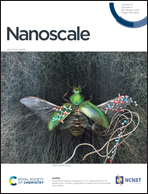AIE nanodots scaffolded by mini-ferritin protein for cellular imaging and photodynamic therapy†
Abstract
Photodynamic therapy (PDT) is one of the most elegant cancer treatment strategies that can be controlled by a beam of light with non-invasion, precise control, and high spatiotemporal accuracy. An ideal photosensitizer (PS) is the key to ensure the efficacy of PDT. Due to their hydrophobic and rigid planar structures, most traditional PSs are prone to aggregate under physiological conditions, which causes fluorescence quenching and significantly reduces reactive oxygen species (ROS) generation. Fortunately, the emergence of aggregation-induced emission (AIE) dyes offers a potential opportunity to overcome these limitations. When AIE PS molecules are in the aggregation state, the fluorescence intensity and ROS production can be increased. We herein use red AIE PS molecules to prepare stable AIE nanodots for cell imaging and PDT via a simple method with a highly negatively charged mini-ferritin protein as the scaffold. The as-prepared protein-AIE nanodots show strong fluorescence emission and efficient singlet oxygen generation, with good stability, relatively long wavelengths of absorption and emission, and negligible dark toxicity. The mini-ferritin-AIE system may be useful in developing novel functional probes for tumour nanotheranostics.

- This article is part of the themed collection: 2020 Nanoscale HOT Article Collection


 Please wait while we load your content...
Please wait while we load your content...